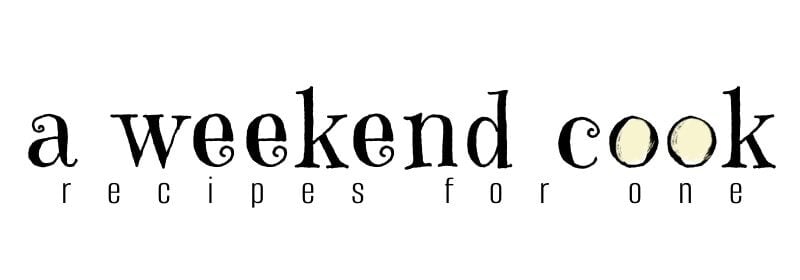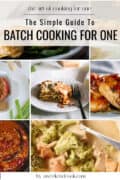Batch cooking for one can be a game-changer, saving you time, money, and stress throughout the week. If you are someone who enjoys having home-cooked meals without the daily hassle, this guide will help you get started. From the best tools to essential tips, here’s everything you need to know to start batch cooking and freezing single-serving portions.
More easy tips to master the art of cooking for one.

Why Batch Cooking?
Batch cooking involves preparing large quantities of food at once and then portioning them out for future meals. I like to plans one month ahead. Depending on your circumstances you may like to indulge in takeout or dine out with friends is couple of times a week. A good place to start is with 16 meals per month. I’m a spontaneous cook so in general meal planning doesn’t fit my lifestyle, however batch cooking work well. There is a good chance there will be a day or two that I just don’t want what I’ve previously prepared.
Once you know if this is right for you you can increase the number of meals you prepare. This approach has numerous benefits:
- Time-saving: Spend less time cooking daily.
- Clean-Up: it’s easier to cook several meals at once and deal with one big cleanup, rather than tidying up the kitchen every night after cooking.
- Cost-effective: Buy ingredients in bulk and reduce food waste.
- Convenient: Always have a meal ready to go, reducing the temptation for takeout.
Handy Tools for Batch Cooking
- Freezer-Safe Containers: Invest in a variety of containers in different sizes. Glass containers with airtight lids are ideal as they can go from freezer to oven/microwave directly.
- Vacuum Sealer: While not essential, a vacuum sealer is a great investment. It helps to preserve food longer by removing air, which can cause freezer burn and spoilage. Vacuum-sealed bags take up less space than containers and are perfect for soups, stews, and sauces. I have the “Anova Precision Vacuum Sealer” and it has been very reliable.
- Baking Dishes: Opt for Bakeware that is freezer-to-oven safe, such as Pyrex or other glass and ceramic dishes. This allows you to cook, freeze, and reheat in the same dish, minimizing cleanup. I love my small Emile Henry casserole dishes and Apilco 12-ounce ramekins.
- Disposable Pans: Disposable aluminum pans are incredibly convenient for batch cooking. They are lightweight, inexpensive, and can go straight from the freezer to the oven. Using disposable pans also means you don’t have to worry about cleaning up—just enjoy your meal and recycle the pan afterward. They are perfect for casseroles, lasagnas, and baked dishes.
- Ziploc Bags: Freezer safe Ziploc Bags are lightweight, easy to store and are great for marinades and sauces.
- Labeling Supplies: Keep a stash of freezer-safe labels and a permanent marker. Label each container with the contents and the date it was prepared.
- Foils and Wraps: Have saran or plastic wrap, aluminum foil, and parchment paper handy.
- Measuring Cups and Spoons: Have extras on hand, personally I have two sets of measuring spoons and several measuring cups.
- Slow Cooker/Instant Pot: These appliances are perfect for making large batches of soups and stews. They also save you time and make cooking easier. If you will be making a fair amount of slow cooker recipes, you want to have two or three. I have a 2-quart, 3-quart and a four quart oval. The 4-quart oval crock pot is great for cooking up a small roast or whole chicken.
Getting Started with Batch Cooking
Step 1: Plan Your Meals
Before you start cooking, plan out your meals for a month. Choose recipes that freeze well, such as casseroles, soups, and stews . The recipes on this blog have a calculator in the recipe card to scale the recipe up, so just make the selection for the number of serving you want.
Make a shopping list of all the ingredients you’ll need. I open up a spreadsheet and go through my recipes writing down all the ingredients and the quantities needed so I don’t miss anything.
If you really want to save time, then order your groceries online and have them delivered or do a pickup. If you have a Target nearby, I highly recommend using then as they have great prices and good quality.
Step 2: Prep Your Kitchen and Ingredients
Start with a few house cleaning rules; make sure the counters are clear and the trash is emptied. It s also helpful to fill the sink with soapy water to quickly clean utensils.
Now you have everything you need, time to wash, chop, and prepare all your ingredients before you start cooking. The spreadsheet can come in handy, if you have two recipes both using 1/2 cup of onion, you know to chop up a full cup, you see where I’m going with this. This makes the cooking process more efficient and ensures you have everything ready to go.
Step 3: Cook in Batches
Cook your meals in large batches. Use your slow cooker, Instant Pot, oven or stove to prepare multiple recipes at once. For example, you can have a soup simmering in the slow cooker while you bake a casserole in the oven.
Step 4: Portion and Store
Once your meals are cooked, let them cool completely. Portion them into single-serving containers. Make sure to leave some space at the top of each container, as food expands when frozen.
Step 5: Label and Freeze
Label each container with the contents, reheating or final cooking instructions, and the date. Place the containers in the freezer, organizing them for easy access.
Tips for Successful Batch Cooking
- Recipes: When making a favorite dish, you can double the recipe and freeze the extra servings. If you are batch cooking for one month and a recipes makes a four servings, plan on eating this meal 1 time a week.
- Rotate Your Meals: If you batch cook again before all the previous meals, rotate your meals to ensure you’re eating the oldest ones first.
- Use Freezer-Safe Bags: For liquids like soups and stews, use freezer-safe bags. Lay them flat to freeze, which saves space and makes them easier to stack.
- Keep a Freezer Inventory: Maintain a list of what’s in your freezer and update it as you add or remove items. This helps you keep track of what you have and avoid food waste.
- Freeze Single-Serving Portions: I know it might seem obvious but break the recipe into single serving portions before freezing.
Best Recipes for Batch Cooking
- Soups and Stews: Chicken noodle soup, beef stew, and chili all freeze well.
- Casseroles: Lasagna, shepherd’s pie, and baked ziti are perfect for freezing. For casseroles I like to use a standard size recipe and portion it out into single serving baking dishes for freezing.
- Baked Goods: Don;t forget the sweet treats, it’s nice to have a few ready. Muffins, scones, and banana bread can be frozen and reheated easily. Cookies are great to freeze!
- Rice: Rice freezes and reheats well and is good to have on hand.
- Proteins: Cook and freeze portions of chicken breasts to use for tacos or salads, hamburger meatloaf patties, salmon patties and stew meat are all great to have on hand.
Time Savers
- Onion: You can buy pre-chopped onion and save yourself some time and tears!
- Vegetables: No harm in using frozen chopped vegetables!
- Herbs: Have a variety of herbs frozen herbs in your freezer. If you can;t find the already frozen, then buy fresh and freeze them yourself.
- The Pantry: Keep a well stocked pantry.
Should You Invest in a Vacuum Sealer?
A vacuum sealer is a valuable tool for batch cooking, especially if you plan to freeze a lot of meals. It extends the shelf life of your food and prevents freezer burn. If you’re serious about batch cooking, a vacuum sealer is worth the investment.
Should You Use Disposable Pans?
Benefits of disposable pans:
- Convenience: They can go from freezer to oven without needing to transfer food, saving time and effort.
- No Cleanup: After enjoying your meal, simply recycle the pan. This makes cleanup a breeze, especially for busy individuals.
- Space-Saving: Disposable pans can be stacked easily in the freezer, making the most of your storage space.
- Cost-Effective: They are inexpensive and can be bought in bulk, making them a budget-friendly option for frequent batch cookers.
Downsides of disposable pans:
- Environmental Impact: Disposable pans contribute to waste and are not as environmentally friendly as reusable containers. Although they can often be recycled, this still creates more waste compared to using reusable containers.
- Durability: Disposable pans are not as sturdy as glass or ceramic bakeware. They can bend or become damaged easily, especially when handling heavier dishes.
- Heat Distribution: Disposable pans may not distribute heat as evenly as higher-quality bakeware, which can affect cooking times and the overall quality of your dish.
- Cost Over Time: While inexpensive initially, the cost of continuously buying disposable pans can add up over time, making reusable options more economical in the long run.
Sample Batch Cooking Recipes
In the example below I’ve decided to make 12 portions to eat dinner at home 3 times a week. The linked recipes make one or two serving, use the servings calculator to increase the ingredients for the number of serving you have selected.
I’ll cook the lasagna, chili and meatloaf together because they share the ground beef. Next the Tuscan chicken and Honey Garlic chicken because they share chicken thighs and are both made in a slow cooker. While the slow cooker is cooking I’ll prepare the beef stew.
- Lasagna (2servings)
- Beef Stew (2 servings)
- Tuscan chicken (2 servings)
- Honey Garlic Chicken (2 servings)
- Chili (2 servings)
- 1 pound Meatloaf recipe (2 servings)
With some organization, you can easily make all these fully cooked frozen meals in an afternoon!
Common Questions
Freezer burn occurs when food stored in the freezer loses moisture and becomes dehydrated, leading to dry spots, off flavors, and a tough texture. This happens due to exposure to air, causing water molecules to evaporate from the surface of the food and form ice crystals. To avoid freezer burn, it’s essential to store food in airtight containers or use vacuum-sealed bags to minimize air exposure. Wrapping items tightly in plastic wrap or aluminum foil before placing them in a freezer-safe bag can also help. Additionally, maintaining a consistent freezer temperature of 0°F or lower can reduce the risk of freezer burn.
To maximize space, consider using stackable, flat, and square or rectangular containers as they fit more efficiently than round ones. Vacuum-sealed bags are excellent for reducing air and allowing for flat storage, which can be stacked or laid side by side. Label each container with the contents and date to keep track of what’s inside without having to open everything. Utilizing freezer-safe silicone bags can also be a space-saver since they are flexible and can be easily molded to fit around other items. Lastly, organizing the freezer by grouping similar items together and using bins or dividers can help maintain order and ensure you make the most of the available space.
Batch cooking for one person can be a practical and efficient way to enjoy home-cooked meals without the daily effort. By investing in the right tools and following these tips, you’ll have a freezer stocked with delicious, ready-to-eat meals. Batch Baby Batch!
Feel free to share your batch cooking experiences and favorite recipes in the comments below.


Love the tips and easy actionable steps.